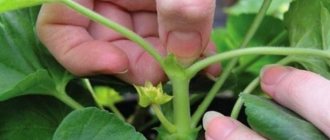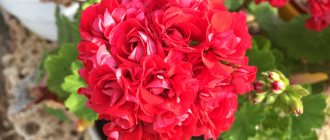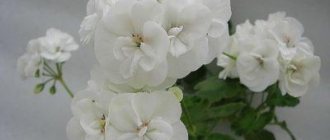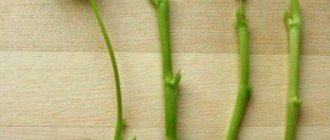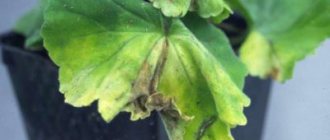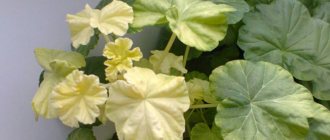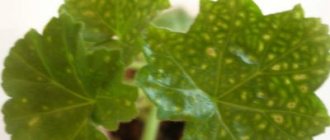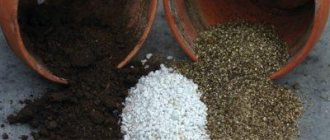Geranium is a very bright, beautifully blooming decoration for any home or apartment. This flower is very popular among both professional flower growers and ordinary amateurs. But despite all its unpretentiousness and ease of care for this plant, for frequent and lush flowering it needs timely and correct pinching of geraniums. Why is it needed and how to do it correctly? How to achieve a lush crown, we will consider further.
Why and when is pinching needed?
Geranium, or as it is also called pelargonium, is a perennial plant that blooms long and luxuriantly. The flower has many medicinal properties and is practically not afraid of insect pests, which it repels with its specific smell. We find geraniums not only in gardens and flower beds, but also on many window sills. Thanks to its unpretentiousness and beautiful flowering, geranium has gained great popularity in our country. But so that this beautiful flower remains compact and attractive. And it didn’t take up half the window sill; it needs to be properly looked after, pinched and trimmed in a timely manner. By using these simple geranium shaping techniques, you will achieve two important goals:
Using hedgehogs to process potatoes
Types of seedling cassettes and their use
Hazelnut - how it grows and blooms, growing a nut in the garden
- Timely pinching will allow the plant to bloom beautifully and profusely.
- In addition, pruning and pinching pelargonium will rid the plant of diseased and weak branches that slow down the growth and development of the flower.
- Pinching delays the flowering period of geraniums, since the nutrients that should be supplied to the upper growth point are spent on the formation of new side shoots. Therefore, this procedure can be used as a regulator of the flowering time of a flower. You need to stop pinching the plant after it has acquired the desired shape and bushiness.
When and how should pinching be done?
Pelargonium should be pinched after the 4th leaf appears, provided that it was grown from seeds. In the container where the flower grows, a small stem of geranium has formed and grown one or two leaves. The flower is still very tiny, but pinching is done to increase the volume of the foliage and prevent the formation of a bare top. If you missed the moment when the pelargonium threw out its first foliage, do not worry, because the deadline for pinching is the seventh leaf, but not later.
If the geranium has grown from a cutting, then you should not try to pinch the leaves too early; you need to wait until the eighth leaf appears, and then act. But watch carefully the development of the flower, because if you skip the tenth leaf, you will only harm the plant.
The essence of the procedure is to remove the growth point of the shoot, which stops its growth in height, as a result of which it branches. If you notice that the branches do not grow from the root system, but from the axil of the upper foliage, then immediately remove them or let them grow to four nodes and pinch them again. The most suitable time for pinching is considered to be the second half of February and the first half of March.
Algorithm of actions during the procedure:
- First, inspect the upper shoots and look for a growth point on them - the largest bud of the shoot, which is responsible for the active development of the flower. If this point is not removed in a timely manner, the begonia will grow in length and will not allow a side branch to form.
- Once you find an active bud, carefully pinch it off. With denser, woody shoots, use tool material. This is done so that the geranium does not stretch and blooms well. During the procedure, you need to ensure that the neighboring young foliage does not wrinkle, and try not to break the main stem of the shoot.
- After the procedure, the stem will not completely stop stretching upward and after a while it begins to stretch again. And thanks to pinching, the buds on the side will have time to bloom and produce fresh shoots.
- Treat pinched areas with disinfectants: alcohol, brilliant green or charcoal. If this condition is not met, the cut sites begin to dry out, and the pelargonium is more likely to get sick.
Recommendations:
- Once pinching is complete, move the geranium to a warm, sunny location. Young shoots need plenty of light to grow quickly and vigorously.
- If unhealthy, infected shoots appear, they must be removed immediately, capturing four centimeters of a healthy trunk.
After pinching:
- Provide indirect sunlight during the spring season.
- In the middle of the growing season, you should move the plant closer to the window and maintain room temperature. A rapid drop in temperature is not scary, because spring will soon be warm. But stuffy air is a terrible enemy of your pet. When it gets warmer outside, ventilate the room.
- Water the flower evenly and in a timely manner, get rid of excess water in the pan, which leads to rotting. So it’s better to underfill than overfill.
- Replant once every 2.5 - 3 years.
- Fertilize in spring. Phosphorus and potassium have proven themselves well, improving not only the root system, but also the leaf mass.
Methods for pruning geraniums
There are three ways to trim:
- main;
- topping;
- autumn
The main procedure is carried out in order to obtain abundant, lush flowering and form a beautiful bush. Autumn pruning is preventative. Pinching is carried out as needed.
Pelargonium should not be injured during flowering - shoots cut during this period are unlikely to be useful for reproduction, and the plant itself will have difficulty healing the cuts. It is better to form the crown of the bush after flowering, so as not to risk the health of your favorite flower.
How to form pelargonium in the fall
After the end of summer, flower growers prepare the flower for wintering. Geraniums are pruned between September and November, after the last bud has dried. During this period, dry yellowed leaves, branches with no foliage and weak shoots stand out. The main stem is shortened by one third, fresh cuts are sprinkled with antiseptics.
If winter buds appear on the flower, they are removed. From late November to March the plant is dormant.
What is the difference between pinching geraniums and pruning?
Pinching is the removal of the point from which a new branch grows. In other words, you just need to cut off the top of the pelargonium stem. Flower growers called pinching “tear off the top.” Thanks to this procedure, young shoots develop from the trunk, thereby the branching of pelargonium gradually increases. Geraniums are usually pinched either in February or March. Some gardeners also recommend pruning the plant in the fall.
Step-by-step instructions for spring pruning geraniums
Held in the last days of February or the first days of March. To begin with, the florist decides on the shape he wants to give to the pelargonium. Then begins the procedure:
- processes the tool;
- reduces the center trunk by one third;
- removes dried branches and foliage, bare shoots or shoots growing towards the middle;
- treats the sections with an antiseptic.
The shoots are cut so that 2-3 buds remain below.
Follow-up care for geraniums includes:
- watering every two days;
- feeding with nitrogen-containing fertilizer;
- absence of drafts and spraying.
Choose a sunny place and, if possible, place it on the balcony or in the garden.
How to prune geraniums in autumn and spring
After the completion of the phase of ejection of peduncles with the gradual withering of existing inflorescences, the time comes for autumn pruning, the purpose of which is not only to form a bush, but also to improve the health of the entire plant.
For this:
- Faded inflorescences, dried or injured shoots are removed, which weaken the plant, preventing new branches from developing.
- Then the elongated, weakened and leafless shoots, which reduce the decorative qualities of the flower, are cut off by ⅓.
- Pruning geraniums in the fall can be done until December, after which the flower is left alone: during the period with short daylight hours, the crop is most vulnerable, and any external influence is stressful for it.
Pinching geraniums
Formation of geraniums from the beginning of development by pinching shows excellent results, the main one of which is the creation of a beautiful bush with minimal intervention.
Pinching petunias for abundant flowering
How to plant Achimenes rhizomes
How to prepare an epin solution for soaking seeds
The procedure is carried out according to the following scheme:
- 2-3 weeks after transplanting a new plant, the apical bud is pinched.
- As the side shoots are pulled out - after the formation of the fourth leaf - another pinching is carried out.
- After the plant acquires the desired shape or bushiness, pinching stops.
Why do you pinch geraniums?
Pinching geraniums serves several purposes:
- stopping the growth of the plant in height;
- the appearance of side shoots (formation of a lush bush);
- abundant flowering.
The procedure helps stop the growth of the main stem. As a result, dormant buds receive nutrition. New shoots appear on the plant. Usually, pinching is repeated several times until the bush takes the desired shape.
Pinching is the removal of the upper part of a young shoot (the so-called “growth point”).
22
How not to harm geraniums when pruning
Pruning geraniums is a simple procedure, especially if you follow the correct sequence and remember the basic needs of the plant, including seasonal ones. Nevertheless, there are times when a bush dies due to rash actions.
The most common mistakes when pruning
A florist needs to know three common mistakes that pelargonium lovers make when pruning:
- If your geranium spends the whole summer outdoors, in the garden or on the balcony, then before autumn pruning it needs to be kept at home for some time. But often amateur flower growers, having brought pelargonium into the house, immediately begin pruning, and then are surprised that it has turned yellow.
- Always clean, rinse and wipe dry the tool after use, and the cutting parts must also be disinfected. If, after pruning a geranium, you introduce an infection without treating the knife, the plant will get sick very quickly, since pruning means a decrease in immunity.
- Often, after drastic autumn pruning, pelargonium trimmed “to resemble a stump” is placed on a lighted windowsill and they begin to water it mercilessly, relying on the fact that natural conditions will do their job. As a result, from excess moisture, the flower develops black stem disease, and simply put, it rots. Watering should be done rarely and little by little, without excessive evaporation from the soil surface and allowing the earthen clod to dry out to a depth of 4–5 cm.
Do all geraniums need to be pinched?
Types of geranium are very diverse: zonal, ampelous, royal, dwarf, fragrant...
In the description of varieties one can often find the promising indication “branching”. For example, in varieties:
- A Happy Thought,
- Ada Suterby,
- Achievement,
- Aunty Pam – Stellar,
- Borthwood – Stellar,
- Carmen Andrea,
- Cherie,
- Lady Gertrude
- Marbacka Tulpan,
- PAC Candy Flowers.
This means that the plant produces more than 1-2 stems and does not require as much shaping as other varieties.
However, experienced gardeners insist: it is better to pinch any geranium so that it grows thicker.
Pinching is the most gentle way of shaping at home. Even royal pelargonium tolerates it well (pelargonium is the correct name for homemade geranium). In most cases, in addition to pinching, formative pruning is carried out. The fact is that the shoots of the plant stretch out very quickly, especially with a lack of light. Then pinching the growth point is not enough.
Standard geranium
Recently, the standard form of the geranium bush has become very popular - the crown is formed in the form of a tall bare trunk, the top of which is crowned by a lush crown, dotted with inflorescences with bright flowers. This shape is achieved using special pruning techniques and is not possible for all varieties of geranium. For a standard tree, it is worth choosing varieties that are large, tall and produce abundant flowering.
The main trunk is exposed, cutting off all the side shoots and tied to a vertical support. In this state, until the required height is reached, usually a meter, the side shoots are removed from the main trunk without touching its tops. When the desired growth is achieved, the upper side shoots are left and pinched, after which the top of the main stem is also pinched.
Caring for a plant is a necessary measure for its long flowering. Unlike many other flowers, geranium is very unpretentious. Don’t be lazy to spend 15 minutes pinching or trimming so that you can enjoy the beauty and aroma of bright pelargonium inflorescences all summer long.
How to pinch?
In order for geraniums to bush, they begin to form them from a very early age. The first time the stem is pinched:
- If the plant is grown from a cutting – above the 5th–10th leaf;
- If grown from seeds, above the 6th–8th leaf.
Side shoots are not allowed to grow more than 4–5 leaves. As for timing, pinching can be done from the end of February until the fall. However, it is important to consider that pinching delays flowering by a period of 2 weeks to 2 months (pruning by 3–4 months).
The best time for pinching is the end of February and March. At this time, the plant begins to awaken after winter. Sap flow increases, so the shoots are formed strong and healthy.
If you form a bush in autumn and early winter, new branches will grow weak. In the cold season, geraniums should be kept cool, but in good light. Then the shoots will not stretch.
Algorithm of actions
The pinching process is quite simple, there is no need to be afraid of it. To pinch geraniums correctly, use the step-by-step instructions:
- Inspect the shoot of the flower you plan to pinch.
- Find the largest bud located between the leaves.
- Gently pinch it off with your fingers or cut it with sharp scissors (knife).
- Place the flower in a warm place with good lighting. For rapid development, young shoots need bright sunlight.
- Watch the flower. If the bud has awakened in the wrong place, carefully remove the sprouts.
In order for geranium to bloom often, you need to form as many young shoots as possible. Woody stems practically do not throw out flower stalks.
General rules
Most types and varieties of geranium easily tolerate formation. The plant recovers quickly, side shoots begin to appear within the first two weeks.
However, no one has canceled the standard safety rules:
- Pinching (trimming) is carried out with a sterile dry instrument or fingers.
- It is important not to pull the shoot, remove the growth point sharply but carefully, without injuring neighboring leaves and shoots.
- Before and after the procedure, the plant is kept dry for 2–3 days (do not water).
- If a transplant was performed, formation begins after 2 weeks.
- Pinching is carried out no more than once every 2 weeks.
- Up to 40% of growth points are removed at a time.
- Places of cuts and pinching are treated with disinfectants - crushed coal, ash, brilliant green.
Shaping weakens the plant and makes it susceptible to disease. Therefore, the ingress of moisture, microbes, and additional stress must be excluded. Compliance with the general rules makes the procedure 100% safe.
During active growth of side shoots, geranium is fed with mineral fertilizers consisting of equal amounts of nitrogen, phosphorus and potassium. In addition, until the bush takes the desired shape, it is not allowed to bloom. Then the geranium grows healthy, beautiful and strong.
